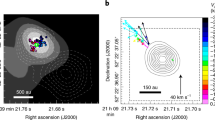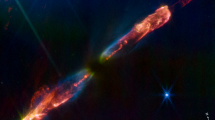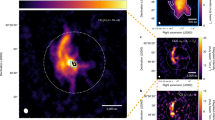Abstract
Protoplanetary disks are known to possess a variety of substructures in the distribution of their millimetre-sized grains, predominantly seen as rings and gaps1, which are frequently interpreted as arising from the shepherding of large grains by either hidden, still-forming planets within the disk2 or (magneto-)hydrodynamic instabilities3. The velocity structure of the gas offers a unique probe of both the underlying mechanisms driving the evolution of the disk—such as movement of planet-building material from volatile-rich regions to the chemically inert midplane—and the details of the required removal of angular momentum. Here we report radial profiles of the three velocity components of gas in the upper layers of the disk of the young star HD 163296, as traced by emission from 12CO molecules. These velocities reveal substantial flows from the surface of the disk towards its midplane at the radial locations of gaps that have been argued to be opened by embedded planets4,5,6,7: these flows bear a striking resemblance to meridional flows, long predicted to occur during the early stages of planet formation8,9,10,11,12. In addition, a persistent radial outflow is seen at the outer edge of the disk that is potentially the base of a wind associated with previously detected extended emission12.
This is a preview of subscription content, access via your institution
Access options
Access Nature and 54 other Nature Portfolio journals
Get Nature+, our best-value online-access subscription
$29.99 / 30 days
cancel any time
Subscribe to this journal
Receive 51 print issues and online access
$199.00 per year
only $3.90 per issue
Buy this article
- Purchase on Springer Link
- Instant access to full article PDF
Prices may be subject to local taxes which are calculated during checkout




Similar content being viewed by others
Data availability
This paper makes use of the following ALMA data: ADS/JAO.ALMA#2013.1.00366.S, ADS/JAO.ALMA#2013.1.00601.S and ADS/JAO.ALMA#2016.1.00484.L. The raw data are available from the ALMA archive (http://almascience.nrao.edu/aq/), while the imaged data and scripts are available from the DSHARP website (https://bulk.cv.nrao.edu/almadata/lp/DSHARP/). The Python packages used for the analysis of the data are available via their GitHub repositories: bettermoments (https://github.com/richteague/bettermoments) and eddy (https://github.com/richteague/eddy).
References
Andrews, S. M. et al. The Disk Substructures at High Angular Resolution Project (DSHARP). I. Motivation, sample, calibration, and overview. Astrophys. J. 869, L41 (2018).
Zhang, S. et al. The Disk Substructures at High Angular Resolution Project (DSHARP). VII. The planet–disk interactions interpretation. Astrophys. J. 869, L47 (2018).
Flock, M. et al. Gaps, rings, and non-axisymmetric structures in protoplanetary disks. From simulations to ALMA observations. Astron. Astrophys. 574, A68 (2015).
Isella, A. et al. Ringed structures of the HD 163296 protoplanetary disk revealed by ALMA. Phys. Rev. Lett. 117, 251101 (2016).
Isella, A. et al. The Disk Substructures at High Angular Resolution Project (DSHARP). IX. A high-definition study of the HD 163296 planet-forming disk. Astrophys. J. 869, L49 (2018).
Teague, R., Bae, J., Bergin, E. A., Birnstiel, T. & Foreman-Mackey, D. A kinematical detection of two embedded Jupiter-mass planets in HD 163296. Astrophys. J. 860, L12 (2018).
Pinte, C. et al. Kinematic evidence for an embedded protoplanet in a circumstellar disk. Astrophys. J. 860, L13 (2018).
Szulágyi, J., Morbidelli, A., Crida, A. & Masset, F. Accretion of Jupiter-mass planets in the limit of vanishing viscosity. Astrophys. J. 782, 65 (2014).
Morbidelli, A. et al. Meridional circulation of gas into gaps opened by giant planets in three-dimensional low-viscosity disks. Icarus 232, 266–270 (2014).
Fung, J. & Chiang, E. Gap opening in 3D: single-planet gaps. Astrophys. J. 832, 105 (2016).
Dong, R., Liu, S.-Y. & Fung, J. Observational signatures of planets in protoplanetary disks: planet-induced line broadening in gaps. Astrophys. J. 870, 72 (2019).
Klaassen, P. D. et al. ALMA detection of the rotating molecular disk wind from the young star HD 163296. Astron. Astrophys. 555, A73 (2013).
Flaherty, K. M. et al. Weak turbulence in the HD 163296 protoplanetary disk revealed by ALMA CO observations. Astrophys. J. 813, 99 (2015).
Rosenfeld, K. A., Andrews, S. M., Hughes, A. M., Wilner, D. J. & Qi, C. A spatially resolved vertical temperature gradient in the HD 163296 disk. Astrophys. J. 774, 16 (2013).
Pinte, C. et al. Direct mapping of the temperature and velocity gradients in discs. Imaging the vertical CO snow line around IM Lupi. Astron. Astrophys. 609, A47 (2018).
Teague, R., Bae, J., Birnstiel, T. & Bergin, E. A. Evidence for a vertical dependence on the pressure structure in AS 209. Astrophys. J. 868, 113 (2018).
Kley, W., D’Angelo, G. & Henning, T. Three-dimensional simulations of a planet embedded in a protoplanetary disk. Astrophys. J. 547, 457–464 (2001).
Lin, D. N. C. & Papaloizou, J. On the tidal interaction between protoplanets and the protoplanetary disk. III – Orbital migration of protoplanets. Astrophys. J. 309, 846–857 (1986).
Flaherty, K. M. et al. A Three-dimensional view of turbulence: constraints on turbulent motions in the HD 163296 protoplanetary disk using DCO+. Astrophys. J. 843, 150 (2017).
Gressel, O., Nelson, R. P., Turner, N. J. & Ziegler, U. Global hydromagnetic simulations of a planet embedded in a dead zone: gap opening, gas accretion, and formation of a protoplanetary jet. Astrophys. J. 779, 59 (2013).
Lyra, W., Johansen, A., Klahr, H. & Piskunov, N. Global magnetohydrodynamical models of turbulence in protoplanetary disks. I. A cylindrical potential on a Cartesian grid and transport of solids. Astron. Astrophys. 479, 883–901 (2008).
Johansen, A., Youdin, A. & Klahr, H. Zonal flows and long-lived axisymmetric pressure bumps in magnetorotational turbulence. Astrophys. J. 697, 1269–1289 (2009).
Suzuki, T. K. & Inutsuka, S.-i. Magnetohydrodynamic simulations of global accretion disks with vertical magnetic fields. Astrophys. J. 784, 121 (2014).
Öberg, K. I., Murray-Clay, R. & Bergin, E. A. The effects of snowlines on C/O in planetary atmospheres. Astrophys. J. 743, L16 (2011).
Madhusudhan, N. C/O ratio as a dimension for characterizing exoplanetary atmospheres. Astrophys. J. 758, 36 (2012).
Devine, D. et al. A Lyα bright jet from a Herbig AE star. Astrophys. J. 542, L115–L118 (2000).
Teague, R. & Foreman-Mackey, D. A robust method to measure centroids of spectral lines. Res. Not. Am. Astron. Soc. 2, 173 (2018).
Huang, J. et al. The Disk Substructures at High Angular Resolution Project (DSHARP). II. Characteristics of annular substructures. Astrophys. J. 869, L42 (2018).
Teague, R. eddy. J. Open Source Softw. 4, 1220 (2019).
Bailer-Jones, C. A. L., Rybizki, J., Fouesneau, M., Mantelet, G. & Andrae, R. Estimating distance from parallaxes. IV. Distances to 1.33 billion stars in Gaia data release 2. Astron. J. 156, 58 (2018).
Teague, R. et al. Measuring turbulence in TW Hydrae with ALMA: methods and limitations. Astron. Astrophys. 592, A49 (2016).
Benítez-Llambay, P. & Masset, F. S. FARGO3D: a new GPU-oriented MHD code. Astrophys. J. Suppl. Ser. 223, 11 (2016).
Masset, F. FARGO: A fast eulerian transport algorithm for differentially rotating disks. Astron. Astrophys. Suppl. Ser. 141, 165–173 (2000).
Liu, S.-F., Jin, S., Li, S., Isella, A. & Li, H. New constraints on turbulence and embedded planet mass in the HD 163296 disk from planet-disk hydrodynamic simulations. Astrophys. J. 857, 87 (2018).
Balbus, S. A. & Hawley, J. F. Instability, turbulence, and enhanced transport in accretion disks. Rev. Mod. Phys. 70, 1–53 (1998).
Acknowledgements
This paper makes use of the following ALMA data: ADS/JAO.ALMA#2013.1.00366.S, ADS/JAO.ALMA#2013.1.00601.S and ADS/JAO.ALMA#2016.1.00484.L. ALMA is a partnership of the European Southern Observatory (ESO; representing its member states), the National Science Foundation (NSF; USA) and the National Institutes of Natural Sciences (Japan), together with the National Research Council (Canada), the National Science Council and the Academia Sinica Institute of Astronomy and Astrophysics (Taiwan), and the Korea Astronomy and Space Science Institute (Korea), in cooperation with Chile. The Joint ALMA Observatory is operated by ESO, Associated Universities, Inc./National Radio Astronomy Observatory (NRAO), and the National Astronomical Observatory of Japan. The NRAO is a facility of the NSF operated under cooperative agreement by Associated Universities, Inc. R.T and E.A.B. acknowledge funding from NSF grant AST-1514670 and NASA grant NNX16AB48G. J.B. acknowledges support from NASA grant NNX17AE31G, and computing resources provided by the NASA High-End Computing (HEC) Program through the NASA Advanced Supercomputing (NAS) Division at Ames Research Center and by the Extreme Science and Engineering Discovery Environment (XSEDE), which is supported by NSF grant number ACI-1548562.
Author information
Authors and Affiliations
Contributions
R.T. devised the method and analysed the data. J.B. ran the hydrodynamic simulations. All authors wrote the manuscript and were participants in the discussion and interpretation of results, determination of the conclusions and revision of the manuscript.
Corresponding author
Ethics declarations
Competing interests
The authors declare no competing interests.
Extended data figures and tables
Extended Data Fig. 1 A comparison of emission heights inferred for the 12CO emission.
The grey points in the background represent individual measurements following ref. 15, while the red contour shows the Gaussian process model of this surface including 1σ uncertainties, as described in ref. 6. Grey lines are random samples from the parametric fit derived from modelling the line-of-sight velocity map, with their spread demonstrating the 1σ uncertainties. The dust gap locations5,28 (D10 to D145) and radial location of the velocity perturbation found7 in 12CO, the ‘CO kink’, are marked. The major axis of the beam is shown for scale at bottom right.
Extended Data Fig. 2 Measured velocity structure of HD 163296.
Top row, projected rotation velocity vϕ,proj; second row, the residual from the 10th-order polynomial fit to vϕ to highlight the small-scale structure; third row, the vR values; and fourth row, the deviation in the shifted and aligned line centre from the systemic velocity. Left and right columns show results using the parametric and non-parametric emission surface, respectively. Velocities in the lower three rows have been corrected for projection effects assuming i = 47.6°. Blue error bars show the inferred velocities assuming both vR and vϕ components, while red error bars assume vR = 0 m s−1.
Extended Data Fig. 3 Measured velocity structure of the gas in the disk around HD 163296.
a, b, As Fig. 2 but using the non-parametric emission surface to deproject the data. Structure in the emission height outside 3″ is due to higher noise in the data, as described in the text.
Extended Data Fig. 4 Gas temperature and sound speed.
The figure shows the derived gas temperature (Tgas, top panel) and the derived gas sound speed (cs, bottom panel) as a function of radius. Error bars show the 1σ uncertainty. The drop in these values in the inner ~30 au (shaded area) is due to beam dilution.
Extended Data Fig. 5 Impact of the choice of velocity baseline.
The figure shows how the choice of vϕ,mod affects the residuals from vϕ, as in the second row of Extended Data Fig. 2. The top panel shows the different underlying models compared to the unprojected data, while the bottom panel shows the residual between the model and the observations. Regardless of the vϕ,mod chosen, the structure in δvϕ = (vϕ − vϕ,mod)/vϕ persists.
Rights and permissions
About this article
Cite this article
Teague, R., Bae, J. & Bergin, E.A. Meridional flows in the disk around a young star. Nature 574, 378–381 (2019). https://doi.org/10.1038/s41586-019-1642-0
Received:
Accepted:
Published:
Issue Date:
DOI: https://doi.org/10.1038/s41586-019-1642-0
Comments
By submitting a comment you agree to abide by our Terms and Community Guidelines. If you find something abusive or that does not comply with our terms or guidelines please flag it as inappropriate.



